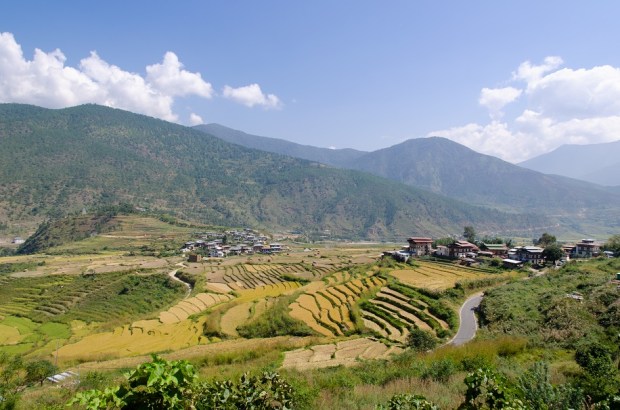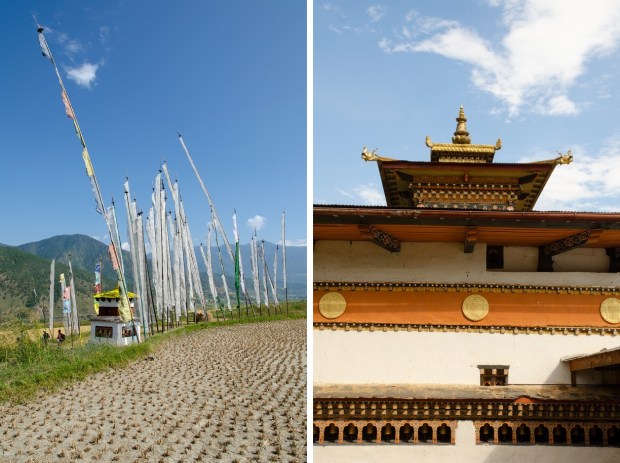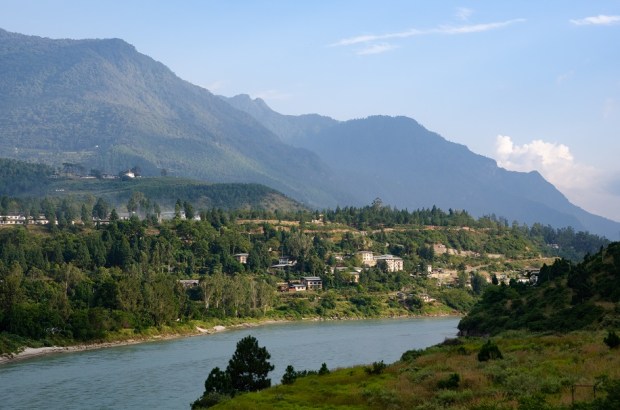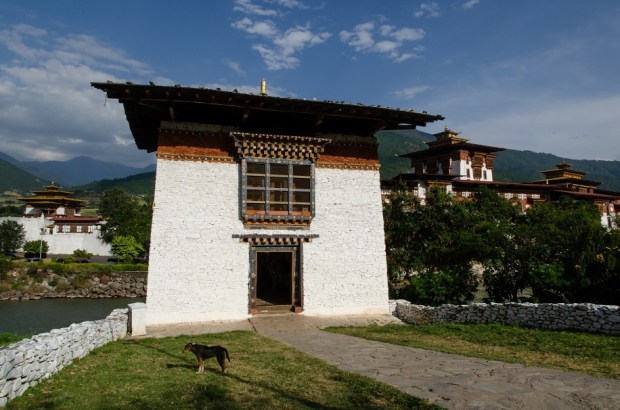Bhutan: Moments from Punakha
As much as I wish it were so, I haven’t secretly escaped from Covid-ravaged Indonesia to seek refuge in the foothills of the Himalayas. Bama and I remain cooped up at home, occasionally snatching glimpses of brilliant blue sky through the windows, imagining the places we’d have gone and long-distance trips that have been deferred indefinitely. But there’s also a realization that we are the lucky ones: despite all that has happened in the past 18 months, both of us still have a regular income, food on the table, a roof over our heads. So many people in this country have seen their livelihoods evaporate and are struggling to make ends meet.
For now, as we ride out the tail end of a catastrophic second wave, much of our weekends are spent sifting through thousands of photos taken on various pre-pandemic journeys. It seems as good a time as any to post more stories from our weeklong sojourn in Bhutan. While the out-and-back hike to Tiger’s Nest is indeed a must-do, Bama and I agree that the highlight was exploring the fertile Punakha Valley, about a three-hour drive via winding mountain roads from Thimphu, the kingdom’s high-altitude capital.
The year is 2018, and a fine October day finds us traveling down a narrow Bhutanese highway inside a minivan, with trusty driver Phuntsho behind the wheel and our guide Kinga in the passenger seat. We’re in good hands. Phuntsho navigates every bend and switchback with a quiet confidence; not once do we feel queasy or perilously close to the edge. When the Punakha Valley eventually comes into view, Bama and I are struck by its timeless storybook appearance.
Spread out below steep hillsides cloaked in chir pine – and flanking a calm, powder-blue river named the Puna Tsang Chhu – lies a gleaming patchwork of rice paddies more beautiful than any I’ve seen outside Indonesia. Village houses built of stone or rammed earth, all with timber-framed trefoil windows, dot the landscape; tall prayer flags adorn the fields and hillsides, fluttering in the breeze. This is Bhutan’s “rice bowl”, a land of plenty where both the red and white varieties of the grain flourish, where farmers can grow all kinds of fruits and vegetables less suited to the colder conditions of Thimphu. The sweaters we wore earlier that morning at cloud-wreathed Dochula Pass, perched 3,100 meters (10,171 feet) above sea level, feel wholly unnecessary.
It’s practically midday by the time we reach Sangchhen Dorji Lhuendrup Lhakhang, a hilltop nunnery with a whitewashed Nepalese-style stupa. Bama and I wander the flagstone courtyard, admiring the handsomely carved eaves and bow-shaped capitals decorating the main prayer hall, as crimson-robed nuns sit conversing on the shaded porch of the same building. Following a hearty lunch of momo (steamed Himalayan dumplings) and empanada-like shabale in the nearby town of Khuruthang, Phuntsho and Kinga take us to Sobsokha. This tiny village is where we first encounter the larger-than-life penises that pop up on countless trip reports about Bhutan. Graphic depictions of tumescent male genitalia, some with fangs and comic eyes, grace the walls of farmhouses, restaurants, and souvenir shops – the latter selling carved wooden wieners painted in every color of the rainbow.
Bhutan owes its obsession with the phallus to Drukpa Kunley, a controversial Tibetan monk and poet who lived more than five centuries ago. Known as “the Divine Madman”, he arrived here after crossing the Himalayas to spread an unusual form of Vajrayana Buddhism. The bawdy missionary quickly became infamous as a promiscuous saint who loved both women and wine. Loathed by the clergy of the time for his shocking, unorthodox ways (such as having sex with followers and urinating on sacred thangka paintings), Kunley proved immensely popular with the ordinary layperson. It’s said that the yogi also battled fearsome demons with his “thunderbolt of flaming wisdom” – in other words, his mighty member. To this day, phalluses are revered in Bhutanese folk culture as a protective symbol for warding off evil spirits and repelling bad luck.
One of Drukpa Kunley’s most legendary exploits involved subjugating a shape-shifting demoness who terrorized travelers at Dochula Pass. The supernatural being could not fool the powerful monk by transforming herself into a dog, and she was soon trapped, killed with his penis, and buried in a great mound overlooking the Puna Tsang Chhu. Atop this hillock, which Kunley said resembled a woman’s breast, his cousin built a modest sanctuary dedicated to the sex-loving saint in 1499. Chimi Lhakhang got its name because the Divine Madman cried “Chi mi!” (“no dog!”) upon defeating Dochula’s demoness.
These days, the place enjoys continued popularity as a fertility temple that draws newly married and childless women from all across Bhutan and other countries like Japan and the United States. British royals Prince William and Kate Middleton are rumored to have paid Chimi Lhakhang a visit some time ago, while Bhutan’s current king, Jigme Khesar Namgyel Wangchuck, and his queen Jetsun Pema are more likely candidates. If either of those pairs really did make the journey, they would have walked there from Sobsokha on a dirt path between the rice fields, passing through another tiny village before treading up the hill.
We’re more than halfway to Chimi Lhakhang when a passing pilgrim returning from the temple stops to hand Kinga a bottle wrapped in a woven carrier. Our guide tells us it is an offering of ara, the local moonshine, and the friendly man had forgotten to deposit it at the altar. In view of the main building and a small chorten (shrine) marking the exact spot where Drukpa Kunley vanquished the demoness, we sit beneath a large bodhi tree as Kinga tells us more about Buddhist beliefs. A departing devotee emerges from the temple doorway to spin rows of prayer wheels set into small, shoulder-height niches in the thick walls of Chimi Lhakhang. Inside the dimly-lit sanctuary, women who seek children are tapped on the head with a ten-inch wood-and-ivory phallus, believed to have been brought from Tibet by the mad saint himself.
Clouds fill the sky over Punakha the next morning as we cruise past the junction with the road leading down from Dochula Pass. We’ve come at just the right time. The fields at Sobsokha appear barren after the harvest, but those up the valley tease our eyes with thousands upon thousands of rice plants, blanketing the landscape in glorious shades of yellow and green: from lemon and lime to moss and chartreuse. Bama and I are so captivated by the scenery that we ask Phuntsho and Kinga several times if we can pull over to take pictures, a request they graciously accept. Then, after descending to a small parking lot on the riverbank, it’s time to cross the glacier-fed Mo Chhu (Mother River) on foot.
Kinga leads us over a chain bridge draped in prayer flags to begin an hour-long hike. Our destination is Khamsum Yulley Namgyal Chorten, a pagoda-like shrine on the crest of a forested hill up ahead. En route, we stop to admire chilies on the branch, ripening rice stalks laden with fat grains encased in their golden husks, a bubbling brook with crystal-clear water, then pine trees soaring above the steeper sections of the trail. Every step yields an even better view than the one before it. Ultimately, our efforts are rewarded with an arresting panorama of the surrounding countryside – bisected by the meanders of the Mo Chhu – from the chorten’s rooftop terrace. It’s not just these vistas that catch the eye; the carvings and elaborate interiors of the four-story shrine are a testament to the skill of Bhutanese craftsmen (the chorten only took shape in 2004). But of all the religious buildings in this secluded valley, none are more magnificent than the nearly 400-year-old landmark downstream.
Punakha’s historical significance as the old capital of Bhutan is encapsulated in its namesake dzong, an imposing fortress-monastery that functioned as the center of both religious and secular power. First built in 1637 on the site of a major victory over an invading army from Tibet just a few years before, this was the brainchild of Ngawang Namgyal, a Tibetan Buddhist lama who resettled in Bhutan and united the warring local fiefdoms into a single country. Punakha Dzong served as the ruler’s seat and a home base for 600 monks; Ngawang Namgyal gave it the name Pungthang Dechen Phodrang – the Palace of Great Happiness. Over the centuries, several earthquakes and floods wrought heavy damage, while fire partially destroyed the dzong on at least six occasions, most recently in 1984. But each time that happened, the massive structure was carefully rebuilt using traditional methods.
To this day, Punakha Dzong functions as the winter residence for the Je Khenpo (Chief Abbot), Bhutan’s spiritual leader and head of the Central Monastic Body or Zhung Dratshang, an institution formed in 1620 by Ngawang Namgyal. (The entire Zhung Dratshang usually spends the coldest six months of the year in Punakha.) The complex also has a special significance for the House of Wangchuck, Bhutan’s royal dynasty. Its first king was crowned within the dzong’s sturdy walls in 1907, and the fortress-monastery naturally became the venue for all subsequent coronations. Perhaps unsurprisingly, the wedding ceremonies of both the current and previous king and queen were conducted here.
Punakha Dzong stands alone, just above the confluence of the Pho Chhu and Mo Chhu (Father and Mother rivers, respectively) in an auspicious but flood-prone location. There was once a time when this compound, the second-oldest and second-largest dzong in the country, was flanked by a pair of roofed cantilever bridges (as this historical photo attests) known in the local Dzongka language as bazam. But the 18th-century bazam across the Mo Chhu was swept away in a 1958 glacial flood that literally reshaped the valley – the freak event tore away so much earth from the river bank that the channel was widened by 20 meters (65 feet). Only the original bridge tower nearest the dzong survived. No traditional bazam could span the now 55-meter (180-foot) gap without intermediate supports, and so a steel-cable suspension bridge was quickly built to reconnect the dzong with Punakha village.
That ungainly crossing no longer exists. Thanks to the efforts of a German NGO called Pro Bhutan, Punakha’s long-lost bridge was reconstructed from 2006–2008 as Puna Mochhu Bazam. Their solution fused age-old Bhutanese aesthetics with modern technology; Swiss engineers overcame the challenge of an overly long single span by concealing steel elements within the wooden structure to guarantee strength and stability. Around the foundations of the new bridge tower, vertical concrete pipes and interlocking “toskanes” blocks (more often used in sea walls) provide flood protection, though you won’t see them as they are hidden beneath hundreds of natural boulders. The entire project was financed by private donations from Germany totaling 850,000 Euros, or just shy of a million U.S. Dollars.
Bama and I have just stepped onto the bridge when we see a familiar face: it’s the friendly traveler from Sydney who sat next to us on the final leg of the flight from Singapore. Because most visitors to Bhutan are often funneled to the same places of interest in a specific geographical order, it’s almost inevitable that you’ll bump into certain travelers again and again. Just that morning, we encountered the guy while taking pictures of Punakha Dzong from across the river. At a chance meeting on the edge of Thimphu’s Clock Tower Square two days earlier, the Sydneysider kept remarking that everything in Bhutan was “weird.” At the time I wanted to counter that Australia was weird in its own way, not least because of vegemite and marsupials and its rather endearing accents (“No” in Australia is pronounced nah-oouu). But it was clear that the magic of Bhutan was lost on him. “I’m not interested in the history, culture, or religion,” he told us. “I told the tour agency that I only wanted to do photography.”
Now, he leans in close with a smirk, and half-whispers within earshot of Kinga, “There’s not much to see inside.” Our guide politely chuckles as the man from Sydney takes his leave. The glib Australian is wrong, of course. Anyone who has even the tiniest appreciation of architecture will find much to admire in this masterpiece of Bhutanese craftsmanship. Exquisitely carved geometric patterns grace the timber facades; look closely and you will spot the faces of mythical creatures like snow lions and dragons peering out from lintels, cantilevered beams, and wooden bas-reliefs. We cannot decipher the swirling patterns on the bow-shaped timber brackets (zhu) above the sturdy columns (kachen) encircling the first of Punakha Dzong’s three courtyards. Even railings (jadhang tazi) have been embellished with cloud-like motifs, dragon heads, and Dharma wheels; their vertical posts are capped by lotus bud-shaped norbu tog, or wish-granting treasures.
One of the few interior spaces accessible to tourists is the Kunrey, the dzong’s “100-pillar assembly hall”. Our jaws drop when Kinga leads us inside after we leave our shoes below the entrance steps. No surface, except for the wooden floor, has been left undecorated; the finery and level of detail surpasses even that of Beijing’s Forbidden City. I feel as though I’ve been enveloped in the deep religious devotion of hundreds and hundreds of Bhutanese artisans. The walls depict the 12 episodes of Buddha’s life in vivid, exuberant colors, while soaring cypress pillars sheathed in gilded brass plates guide the eye upwards to the painstakingly carved zhu. Straight ahead, a 10.6-meter (35-foot) image of the Buddha Shakyamuni commands the sacred space, flanked by 8.5-meter (28-foot) statues of Guru Rinpoche (a.k.a. Padmasambhava) – the eighth-century vajra master from India credited with bringing Tantric Buddhism to Tibet and Bhutan – and Ngawang Namgyal. (This photo gives you an idea of what we saw, as does this one taken during the king’s coronation in 2008.)
Bama and I float back out of the Kunrey and return to the dzong’s innermost courtyard. Between the main prayer hall and the three-story Machey Lhakhang, the temple housing the embalmed remains of Ngawang Namgyal himself, we see pine trees and fields cascading down a verdant hillside across the Mo Chhu. Long shadows trail the fellow visitors milling about on the flagstones as the walls of whitewashed stonework glow like marble in the late afternoon light. Kinga says nothing but I instinctively know there’s still time to linger. Bathed by the warm October sun in this magical place where Buddhist spirituality intersects with artistic brilliance, I feel wholly and utterly at peace. ◊













































This is a truly memorable place. We have been looking through our photos of the valley, the same places that you visited and wondering when we could go back. Our visit was ten years before yours, and we do think it is time to visit again. What a wonderful place it was! And your photos and descriptions make our nostalgia even stronger.
How lucky you are to live in the country right next door to Bhutan – and to be exempt from visa requirements too. I’m incredibly thankful that Bama and I got to visit before the pandemic. Our weeklong trip with a 16-hour stopover in Singapore would be impossible to pull off these days. Who knows, perhaps you’ll be among the first international visitors to enter Bhutan after it reopens for tourism.
Yes, a long flight with changes seems like a dream or a nightmare now. I will be so happy to travel anywhere far that I wouldn’t mind being the last in line.
Those are wonderful photos of an amazing place.
Thank you – I think we really lucked out with the timing on this trip. Had we arrived a couple weeks later, it’s likely that most of the rice fields would have been cleared.
What a magnificent monastery. What is it with some Australians? That’s exactly what one said to me when I entered Manjanggul Lava Tube on Jeju Island and to me, there was much more to see! Brought up on tales of evil step-mothers and wicked witches, I’m wondering if there’s any culture that doesn’t depict women as the evil ones.
It was so strange – you’d think the solo traveler would take a fleeting interest in the culture (and architecture) of Bhutan after spending all that money to get there from Sydney. I’ve been reading a bit more on Drukpa Kunley and the story goes that he did defeat quite a few male demons with his you-know-what. It’s good to know those evil beings weren’t exclusively female.
Wonderful pics! Reminds me of my own trip to Bhutan 8 years ago.
Cheers, Edwin! I suspect Bhutan hadn’t changed very much in the five years between our visits – well maybe except for Thimphu, which felt like it was in the middle of a building boom.
They were already building lots of new houses when I was there. Looks like they didn’t stop 😂
You have a way of bringing a place alive with your words James. And what a wonderful series of photos especially of the terraced paddy fields and that splendid Dzong. What’s the point of photography without connecting to the culture and the stories? It’s the strangeness I cherish in my travels:)
Thank you so much, Madhu. Strangely, I didn’t jot down a lot of notes at the time (though I did document our encounters with that man from Sydney), so it took a while to reconstruct the experience based on my memories and the hundreds of photos I took there. Good thing there’s a wealth of historical information floating around the Internet to help fill in the gaps. When you do eventually go, I’m sure you will love Punakha as much as Bama and I did!
Reading this post reminds me of the peacefulness I felt throughout our journey in Bhutan. I remember repeatedly taking a deep breath on top of Khamsum Yulley Namgyal Chorten because fresh air is something we can’t get in Jakarta. Punakha Dzong is one of the most impressive and beautiful buildings I have ever seen in my life. I just can never get bored of looking at my photos and yours on the dzong’s architectural details, bathed in the warm afternoon sun. The people in the Himalayan region do know how to build magnificent structures.
Yes indeed, there is something so inherently special about that part of the world. The fragrant aroma of pine and the fresh mountain air will prompt any city-dwelling visitor to spend more time outdoors; it was such a wonderful change of pace to slow down and go on multiple walks and hikes over that week. I wouldn’t mind revisiting Punakha Dzong when we eventually return to Bhutan – the valley seems like a natural place to stop for a day or two before heading out east to Gangtey, Trongsa, and Bumthang.
Oh this is so beautiful. A friend of mine visited Bhutan a couple of times and he posted some pictures on his IG. I would love to visit there one day. I’m still puzzled why that tourist said there’s nothing to see. Thanks for sharing the photos and doing such a wonderful write up.
My pleasure, Matt – thanks too for taking the time to read this rather long post. With overseas travel being put on hold for more than a year now, I found it therapeutic to go through all my photos from Bhutan. As you can tell, I had a hard time choosing only a few (especially the ones of Punakha Dzong)!
James, I can totally understand why you would feel wholly at peace in a place like Punakha Dzong. The combination of exquisite architecture, soft afternoon sun, and the stunning greenery of the surrounding area is magical. I was surprised to read that the rice fields rival the best you’ve seen; that’s high praise coming from someone who lives in Indonesia. Your beautiful photos have given me a much needed dose of foreign travel.
I think of you and Bama often as I read the devastating news out of Indonesia. I’m happy to hear that you guys are OK. Keep well and keep sorting through those wonderful travel photos!
It’s true that Indonesia sets high standards when it comes to rice terraces or rice fields in general, but the novelty hasn’t worn off since I moved here in 2016. I think a big part of it stems from living in the middle of traffic-choked Jakarta, and seeing rice paddies only when we leave town!
I truly appreciate your thoughts and well-wishes, Caroline. None of my relatives in Canada have been asking how I was, so I just assumed Indonesia wasn’t really covered by the news outlets there! We had a bit of a Covid scare at the end of June when I endured a sleepless night while running a high fever. Bama and I both got tested as a precaution the next day but thankfully the results came back negative. Eventually Bama figured out that it was actually a mild case of dengue fever. Since I’m a mosquito magnet, I just knew it was going to happen at some point!
I think it’s easy to “forget” about the pandemic situations in other countries (except for maybe big brother next door) when living in a place like Canada where we are doing relatively well and getting back to normal life. Mike is a news junky and is all over worldwide COVID-19 stats. Our son’s girlfriend has a sister in Jakarta so we also get insight through her.
Dengue fever…yikes! That must have been a scare. I’m a mosquito magnet too and always come out of these hiking trips looking like I have some terrible skin disease.
Take care of yourselves!
I’ve been following the global vaccine rollout and it is encouraging to see just how high the uptake is in Canada – it looks like that is really paying off these days.
Here in Jakarta things are really being sped up, but at the same time it is disheartening to see the massive vaccination gap between the capital and the rest of the country (more than 80% of people here have already had their first dose, compared to just over 20% nationwide).
My extended family in Canada and the US are already talking about organizing a family reunion somewhere in Europe next summer, but I’m not sure I will be able to join. To be honest, I think it will take much longer for Southeast Asia to emerge from the pandemic. Whatever travel happens in the next 12 months will either be domestic or short hops to neighboring countries like Malaysia and Thailand after borders reopen.
Take care too, Caroline!
The views of magnificent Punakha Dzong and that incredible verdant valley bring back such great memories (even though the whole Punakha Valley was a substitute for a snowed-out trek we had planned back in 2019). We never saw the plethora of “wooden wieners,” as you so hilariously put it, but we did learn of the story behind them. I can’t imagine visiting a country so steeped in history, culture, and spirituality as Bhutan and not caring a whit about that, but I hope the Sydney visitor picked up even the teeniest hint of the magic and that it surfaces someday in his memories! Meanwhile, thanks for sharing yours!
I recall your deep disappointment at the cancellation of that much-awaited trek in the Haa Valley. And all the more so because it was the very reason you’d booked the trip and flown halfway around the world. I can’t really complain about our experience hiking to Tiger’s Nest in the rain and mist – we still had a great time, and more importantly, we could still reach the monastery and trudge back down to the trailhead in time for a hearty (and excellent) Bhutanese lunch. In any case, your recent road trip out west seemed to signal an end to your run with bad weather!
Everything about this place is gorgeous – from the views, to the shrieking-green rice terraces to the beautiful architecture with its decorative details. Absolutely stunning. I can see why this area was a highlight for you.
I am completely gobsmacked by the comment from the Aussie guy. Gobsmacked as in speechless. I would imagine he’s not much of a photographer if he had no interest in the country and thought there was not much to see inside the dzong.
Alison
At one point the guy from Sydney boasted how he’d gone on safari in Africa and photographed the wildlife. He struck me as the sort of person who goes on bucket-list trips just for the sake of it, without really “seeing” and immersing himself in the place as you or I would. Bama and I were relieved that we didn’t encounter him again the rest of the trip. Had we seen him on the hike to Tiger’s Nest, I have no doubt that he’d be moaning about the wet weather!
He sounds obnoxious, and a bit too full of himself to be able to really experience a place. Sad.
Totally agree with you, Alison. If I were him, I would have a folder full of the Dzong’s photos 🙂 Those carved ornaments are just exquisite.
So beautiful, James! The nature, the architecture. It’s interesting how palluses mean a lot to Bhutanese. Okay, now I remember the name of the village, Sobkho.
About the pandemic, same to you two, I’m really grateful that my job isn’t affected by this. I mean, social media is our service. I usually spend weekends by watching travel vlogs, Netflix, or stay at nearby hotels 🙂
Bhutan is absolutely stunning – I hope you make it there someday, Nugie. It’s definitely not cheap, but the trip is worth every penny. Bama and I did not regret it at all. Living in heavily polluted Jakarta, I especially miss the fresh mountain air, the cleanliness, and seeing nature at just about every turn.
Yes, I want to, James. I know it’s expensive due to its low demand from travelers and high tax from government. But maybe those are the way to keep the heaven pristine.
Thanks for sharing this post, James! The landscape is amazing. Exactly how I’ve imagined about Bhutan. But what holds my attention is the Punakha Dzong – an architectural wonder. The style and the decorations are just magnificent. It is also interesting to know that the building still retains its original form despite multiple re-constructions.
I wonder why the man from Sydney travelled to Bhutan in the first place. If he just wants photos for the bucket list, he can buy a green screen. It is much cheaper than a trip to Bhutan 🙂
You’re welcome, Len! It’s funny how it took a pandemic for me to finally sort through the photos and publish more stories from Bhutan. Punakha Dzong is jaw-dropping in its beauty – in my opinion it is totally worthy of being listed as a UNESCO World Heritage Site.
And I agree about the tourist from Sydney… on the upside, a sizeable chunk of the money he paid went to supporting local education and conservation initiatives. That’s never a bad thing! 🙂
Haha so true!